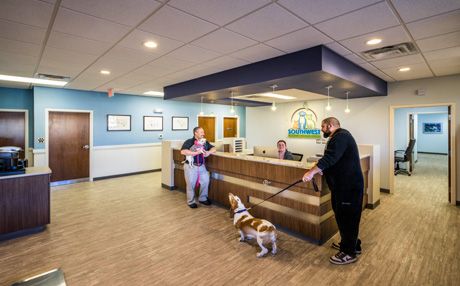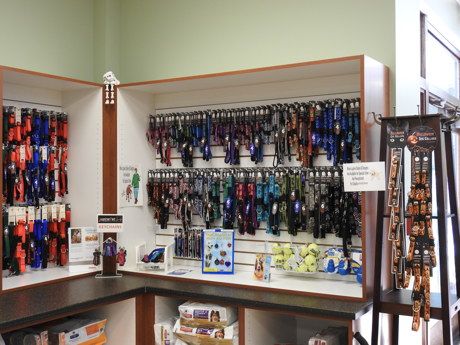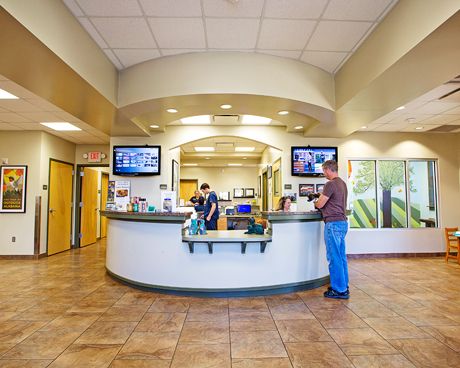6 hospital dcor rules to live by
Use these tips from veterinary architect Dan Chapel to get your design straight.
In his 40-year career, Veterinary Economics Hospital Design Conference educator Dan Chapel, AIA, of Chapel Associates Architects in Little Rock, Arkansas, has learned a thing or two about décor principles to guide your practice's style. Keep these simple tips in mind and you'll be off to a great start.
1. No décor smaller than a basketball

Carolina Ranch Animal Hospital & Resort in Garner, North Carolina, uses display cabinets around their front desk to keep small items on view but manageable. | Photo courtesy of Paul Potera
Small items not only attract dust and grime, but they're easy for pets, clients or clients' kiddos to knock over. If you do have smaller pieces you'd like to display, “try grouping them together to form a larger item,” Chapel says. “Or try putting them together in a wall display or frame.” For small pictures or plaques, instead of scattering them one-off, arrange them in a gallery wall for a more cohesive look.
2. If it's important enough to put on the wall, it's important enough to frame

Southwest Veterinary Medical Center in Albuquerque, New Mexico, has art nicely framed for display on their walls. | Photo courtesy of Kirk Gittings, Kirk Gittings Photography
Have diplomas and art professionally framed. If it's important enough to display, it's important enough for a frame. Even if it's a free poster you got from a sales rep, it'll look much nicer in a frame. Stick it up with tape and it looks cheap, Chapel says.
As a busy veterinarian in your community, you probably get a lot of announcements of community events or lost pets, which is great, but don't just stick them up with scotch tape.
“Put up a framed bulletin board and clean it of past-dated items regularly to contain clutter,” Chapel advises.
3. Keep your tone friendly
If there are rules or guidelines you'd like to post for clients to see, such as “Please keep pets on a leash or in a carrier” or “Payment is due at time of service,” keep your tone friendly and make the signs look nice. A hastily scribbled sign slapped up with tape isn't going to make clients feel welcome.
Try phrases such as, “For the protection of your pet and others, please keep your furry friends on a leash,” Chapel says.
This rule doesn't only apply to the inside of your building, but anything you'd post in your parking lot or on the exterior of the building. A sign with big bold lettering and shouting in all caps, “STAY OUT OF THE BUSHES!” will feel threatening to people coming to your practice.
4. Believe in your retail space

Veterinary Healthcare Associates in North Augusta, South Carolina, has a neat and tidy retail space full of high-quailty items that clients will love. | Photo courtesy of Samantha Thomas
If you wouldn't use an item or recommend it, don't sell it in your retail area, Chapel says. You don't want to show off items in that space only because you got a good deal on them. You should like and recommend the products you sell.
“Try to have items that are better-quality or have better features than a client can get at Walmart or PetSmart, and things that you stand behind professionally,” Chapel says.
5. Don't bombard your clients

Flint River Animal Hospital and Bed 'N Biscuit in Huntsville, Alabama, has TVs for client entertainment and education behind their reception desk-kept at a reasonable volume, of course. | Photo courtesy of Suzy McGehee
Big TVs are relatively cheap now, Chapel notes, and everywhere you go there's a TV on the wall blaring the news or talk shows. If you want to have a TV in your waiting area, be careful with the content you're showing and the volume level.
“This is especially important for the front desk staff, who have to listen to it all day, every day, while trying to help customers and competing with the noise from the TV,” he says. “It's crazy enough with just pets in the reception area. The TV doesn't have to take it to another level.”
6. Hold regular inspections
Hold an inspection every so often to gauge the cleanliness and maintenance needs of your building. “If you're coming in and going out the back door each day, you may have no idea there's three feet of baseboard missing where someone banged into it with a kennel,” Chapel says. Inspect your property as well, because your parking lot and landscaping need regular cleanups.